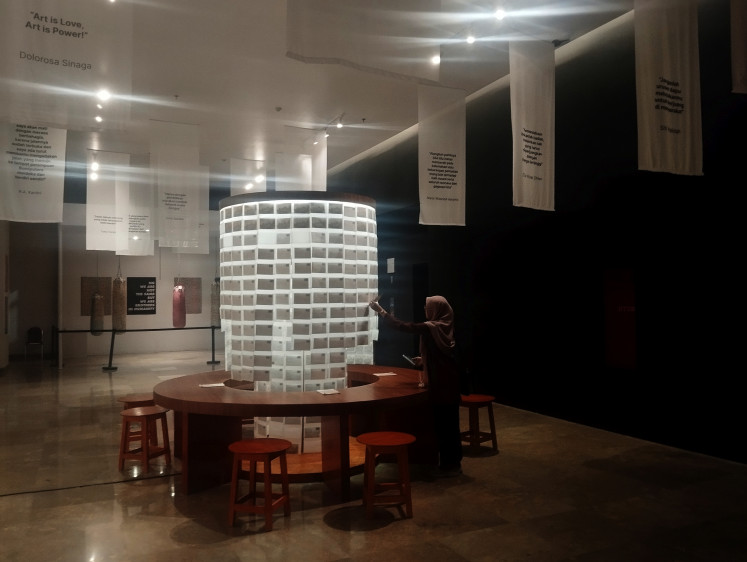May 20, 2025
JAKARTA – A 13th-century statue of Prajnaparamita, the Buddhist goddess of wisdom, welcomes visitors to a new exhibition at the National Museum in Central Jakarta titled Sunting: Jejak Perempuan Indonesia Penggerak Perubahan (Sunting: Footprints of Indonesian women as drivers of change).
According to the Negarakretagama manuscript, the statue is a representation of Queen Gayatri Rajapatni, who was known for her wisdom and influence on leading figures of the Majapahit Empire. These include her mentee, the powerful military leader and mahapatih (prime minister) Gajah Mada and her grandson Hayam Wuruk, the reigning king during the height of the empire.
It also represents women’s influence in ancient times and as such, marks the starting point of the historical journey presented in the exhibition, which opened on April 21 in conjunction with Kartini Day and runs until July 31.
The gallery featuring ancient objects is followed by a section that highlights the contributions of women pioneers during the colonial era in education, medicine and journalism.
A letterbox belonging to Kartini, the eyeglasses of educational reformer Nyi Hadjar Dewantara, the photo album of physician Marie Thomas and articles by journalist Roehana Koeddoes are all on display.
The exhibition was named after Soenting Melajoe, a women’s newspaper Roehana founded in 1912 in West Sumatra. The word soenting refers to a traditional female headdress, but it also means to edit.
“The women’s stories featured in this exhibition, including Roehana Koeddoes’s, represent the spirit of ‘editing’, meaning they reshaped their lives, communities and nation through various acts of struggle,” said exhibition curator Sabila Duhita Drijono.
On one wall, a timeline presents a brief history of women’s activism in Indonesia, while the works of contemporary thinkers including Saparinah Sadli, the first chairperson of the National Commission on Violence against Women (Komnas Perempuan), and philosopher Toety Heraty invite visitors to explore how they helped redefine the role of women in a patriarchal society.
Other prominent figures featured in the exhibit include Emiria Soenassa, the first female painter from North Sulawesi, legendary singer and songwriter Titiek Puspa and pioneering fashion designer Non Kawilarang.
Captivating arts
Held in collaboration with historians, artists and curators, the Sunting exhibit has drawn a wide range of visitors to the National Museum.
Among them is Fiori Violetta, a 27-year-old social media specialist who came with her two friends earlier this month and was captivated by the intricate carvings of the Prajnaparamita statue, which she said was her favorite piece.
Fiori was also drawn to the section showcasing archival materials on pioneering female doctors Anna Warouw and Marie Thomas, who studied at School tot Opleiding van Inlandsche Artsen (STOVIA), or the Training School for Native Physicians, especially photographs that offered a glimpse into their lives at a time when medicine was heavily dominated by men.
“I did not realize there were female doctors back then,” she said. “It is interesting, because this kind of information is not always included in the history textbooks. Maybe it should be.”
Stefer, a 36-year-old former mixed martial arts athlete, was also impressed by the exhibition. He took his time reading the display labels, each item introducing him to the many influential women who helped shape Indonesia’s history.
“I think the exhibition is really interesting,” he said.
“There was a section about Ibu [Mrs.] Tien, and I realized there were so many remarkable Indonesian women in the past,” Stefer said, referring to the former first lady and wife of second president Soeharto.

‘Menjadi Dian yang Tak Padam’ (To be an unquenchable light), an installation art by Ika Vantiani, depicts women’s ideas that continue to shine and inspire others on May 2, 2025, at the “Sunting: Jejak Perempuan Indonesia Penggerak Perubahan” exhibition at the National Museum in Central Jakarta. PHOTO: THE JAKARTA POST
Room for contemplation
After exploring the works, ideas and stories of women’s struggles across different eras, the exhibition concludes with an interactive installation art by Ika Vantiani titled Menjadi Dian yang Tak Padam (To be an unquenchable light).
Inspired by the works and writings of prominent women, the artwork depicts their legacies as dian (lamp or light), symbolizing how their ideas continue to shine and inspire others across time.
“Each woman in this exhibition is a light, not only for herself but also for those around her,” Ika explains in the description accompanying her work.
Made of postcards pinned to fabric shaped around a cylindrical tower with an inner lighting mechanism, visitors are invited to take a postcard, write their thoughts on the stories, struggles and contributions of women across the generations and add it to the installation.
“Ika’s work invites visitors to participate in the story because the struggle of women does not end here,” Sabila said.
“We are all still part of this long journey toward change.”


